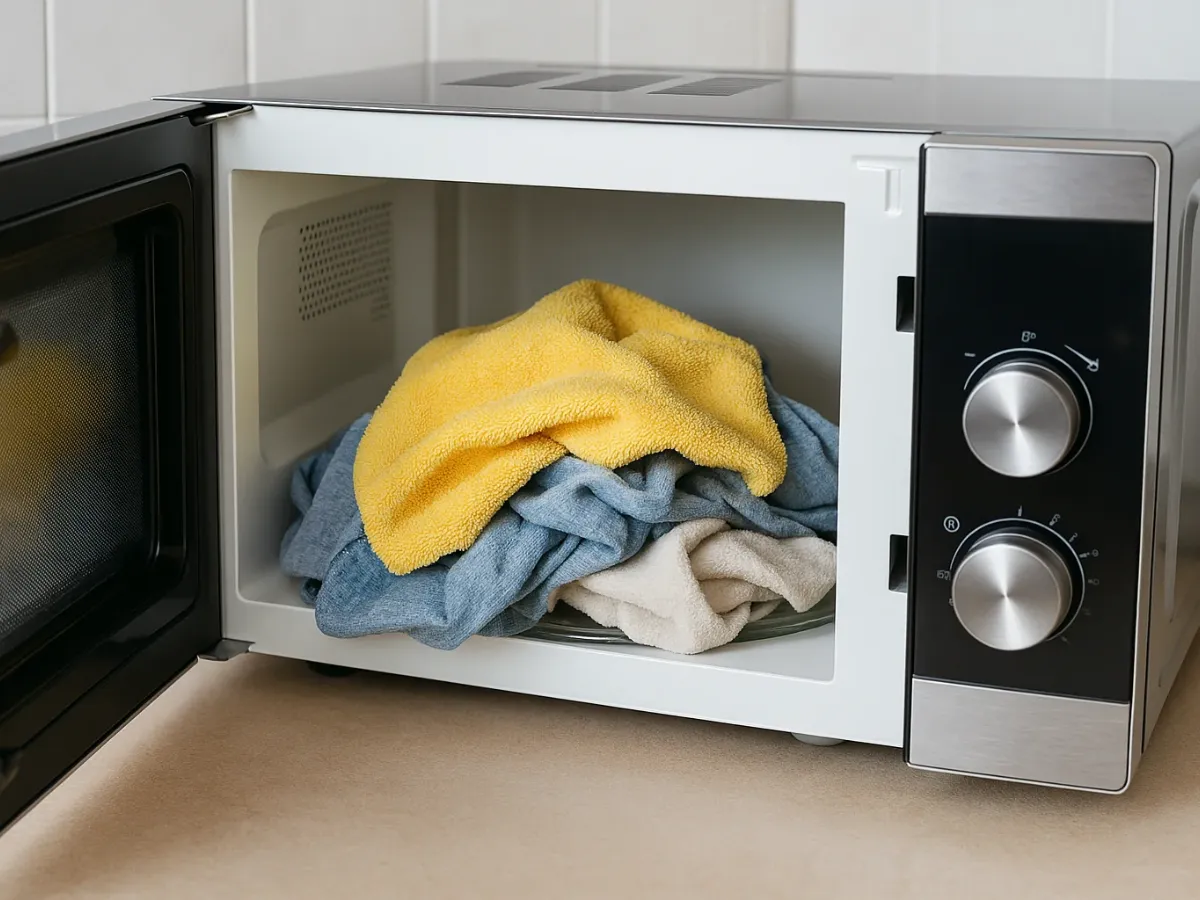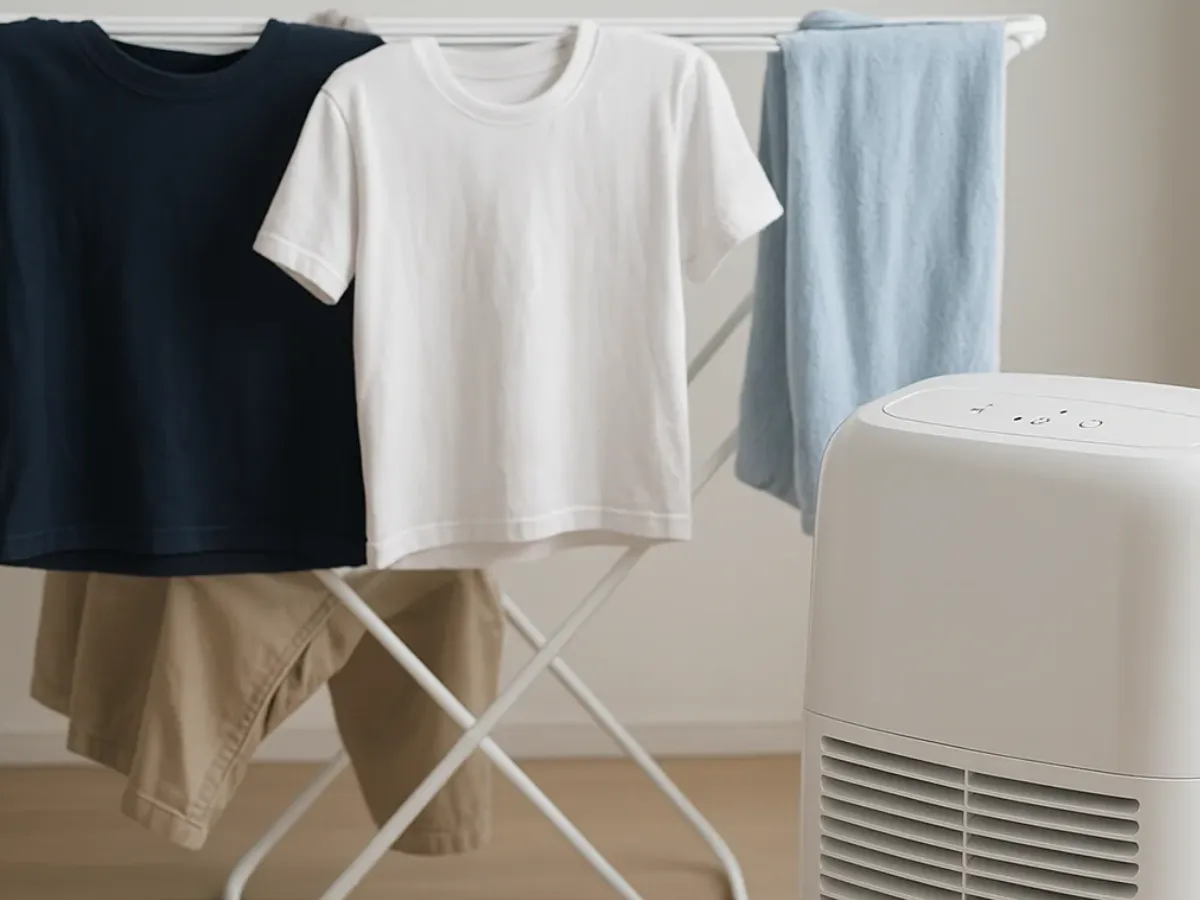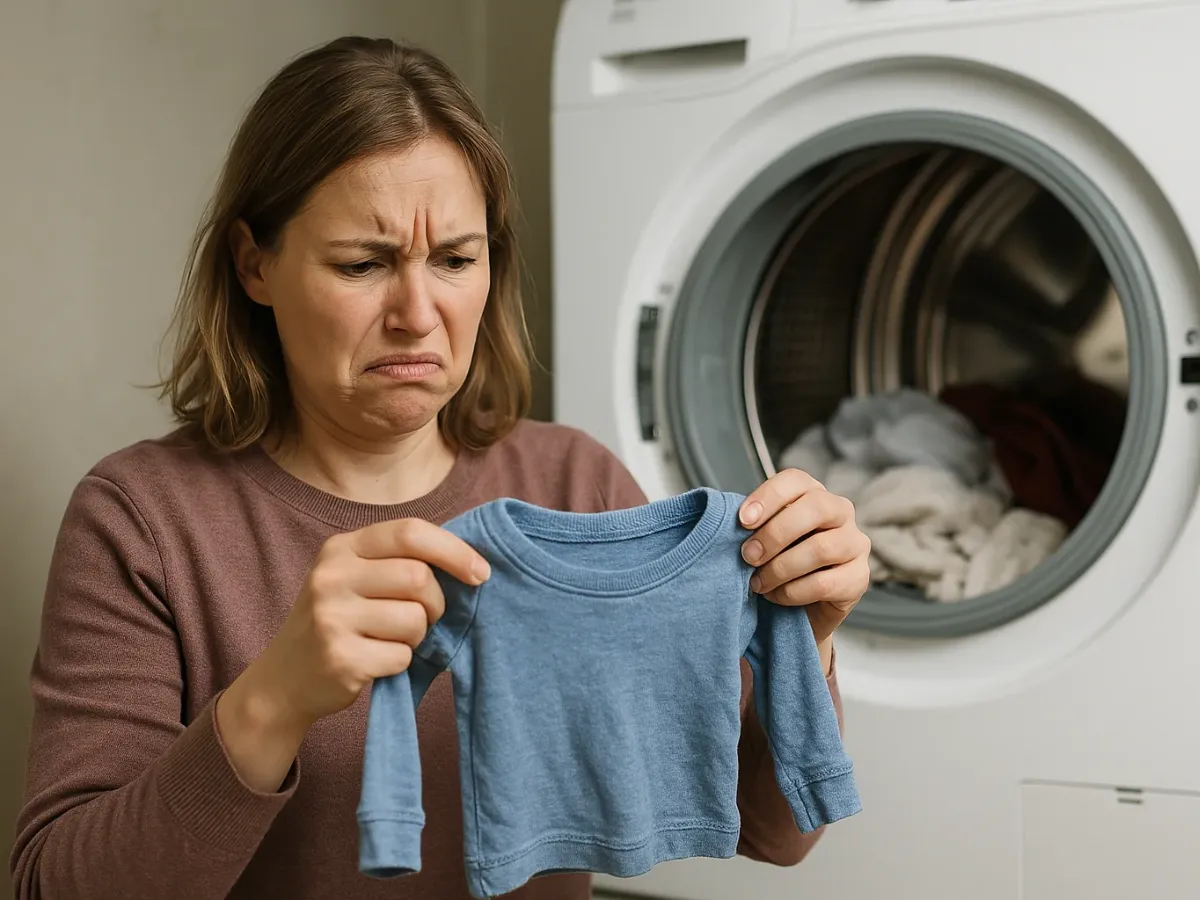Drying Clothes in Microwave: A Quick Trick or Imminent Danger?

You're in a bind. You need that shirt or pair of socks dry NOW!, but the dryer is busy, you don't have one, or it's simply pouring rain outside. In a moment of desperation, you search for quick solutions online and find a "hack" that sounds almost magical: drying clothes in the microwave. Does it really work? Is it safe? Before you put that damp garment next to the popcorn, stop and read on!
While technically a microwave heats and evaporates water, using it to dry clothes is an extremely dangerous and highly inadvisable idea. In this guide, we'll analyze why this "life hack" is a bad idea, the serious risks involved, and offer much safer and more effective alternatives for quickly drying your clothes when you can't wait.
How Does a Microwave Work and Why is it NOT Suitable for Drying Clothes?
To understand the danger, you first need to know how this appliance works. A microwave doesn't generate heat like an oven; it emits electromagnetic waves (microwaves) that rapidly vibrate water molecules present in food. This vibration generates heat through friction, heating the food from the inside out.
Applied to damp clothes:
- Heats Water, Not Fabric Directly: The microwave will heat the water trapped in the clothes' fibers.
- Uneven Heating: The distribution of microwaves inside the oven is not uniform. This means some parts of the garment can dangerously overheat while others barely get warm.
- Steam Buildup: As water evaporates, steam builds up inside the microwave and within the garment itself, which can create extreme heat spots and pressure.
- Not Designed for Textiles: The microwave's components and programming are intended for food, not the structure and composition of fabrics.
DANGER! The Serious Risks of Drying Clothes in a Microwave
Attempting to dry clothes in the microwave exposes you to several serious dangers:
- EXTREMELY HIGH FIRE RISK!: This is the main and most serious danger.
- Fiber Overheating: Uneven heating can cause certain fabric areas to reach very high temperatures, potentially scorching or even spontaneously igniting.
- Synthetic Fabrics: Fibers like polyester, nylon, acrylic, or lycra have relatively low melting points. Microwave heat can easily melt them, ruining the garment and creating a fire hazard.
- Metal Elements: Never put metal in the microwave! Zippers, metal buttons, hooks, underwires, decorative metallic threads... will generate sparks (arcing) that can ignite the garment and severely damage the microwave's magnetron.
- Irreparable Damage to Clothes:
- Burns and Holes: Due to uneven overheating.
- Melting of Synthetics: Leaving hard, deformed, or sticky areas.
- Shrinking or Warping: Intense, uncontrolled heat can irreversibly shrink or warp many garments, especially natural fibers or blends. Much worse than what can happen if the dryer shrinks clothes if used improperly.
- Damage to the Microwave:
- Malfunctions: Sparks from metal or overheating can damage internal components like the magnetron.
- Lingering Odors: The smell of burnt fabric or fumes from clothes can permeate the microwave's interior and be very difficult to remove, contaminating future food.
- Release of Toxic Fumes: Heating washed clothes can vaporize residues from detergents, softeners, or chemicals present in the garment, generating potentially irritating or toxic fumes in an enclosed space.
In summary: The risks far outweigh any potential (and minimal) speed advantage.
What If You Still Want to Try? (At Your Own Absolute Risk)
Although we STRONGLY advise against it, if you decide to ignore the warnings to dry something very small and specific (like a 100% cotton sock with no elastic or embellishments), the "minimum precautions" would be:
- Be 100% sure there is NOTHING metallic.
- The garment must be small and made of durable natural fiber (thick cotton).
- It must be very well wrung out (almost dry).
- Use the LOWEST possible power setting.
- Set VERY SHORT intervals (20-30 seconds MAXIMUM).
- Take the garment out and CHECK ITS TEMPERATURE and condition between each interval. Let it cool slightly.
- DO NOT LEAVE IT UNATTENDED FOR A SECOND! Constant and absolute supervision.
- Have a fire extinguisher or thick cloth handy just in case.
We insist: This is NOT a safe or recommended method.

SAFE and Fast Alternatives for Urgent Clothes Drying
If you need to dry clothes quickly, there are much safer and more effective options:
- The Clothes Dryer: This is the appliance designed for the job.
- Home Dryers: If you have one, use it, selecting the appropriate program and temperature for the garment.
- Self-Service Laundromats (Like LaColada!): They are a fantastic option. Our industrial dryers are very powerful and dry large amounts of clothes in a very short time (often in 15-25 minutes!). It's the ideal solution if you don't have a dryer at home or need to quickly dry bulky items.
- The Hairdryer: For small items (socks, underwear, a damp spot on a shirt...).
- Hang the garment on a hanger.
- Use the hairdryer at a safe distance (15-20 cm / 6-8 inches) with warm air (medium or low heat for delicates).
- Keep the dryer moving constantly over the entire damp surface, inside and out.
- Don't hold it too close or stationary to avoid burning the fabric.
- The Iron (Towel Method): For items that can be ironed.
- Place a clean, dry towel on the ironing board.
- Lay the damp garment flat on the towel.
- Place another clean, dry towel on top of the garment.
- Iron over the top towel with a hot iron (appropriate temperature for the fabric, no steam). The heat will pass through the towel and help evaporate moisture, which will be absorbed by the towels.
- Change the towels for dry ones if they become too damp.
- You can learn how to iron pants and apply a similar technique.
- Drying Rack + Forced Ventilation:
- Hang well-wrung clothes on a drying rack, leaving space between items.
- Place a fan pointing towards the clothes (not too close) to accelerate evaporation.
- If you also use a dehumidifier in the same closed room, drying will be even faster and you'll avoid humidity problems.
- Radiator (With Caution!): You can hang clothes on a drying rack NEAR a radiator (not directly on top, as it blocks heat, can be dangerous, and creates a lot of humidity), ensuring good ventilation in the room.
Frequently Asked Questions about Drying Clothes in Microwave
What happens if I dry my clothes in the microwave?
It's very dangerous: high risk of fire, damage to clothes (burns, melting), damage to the microwave, and release of toxic fumes.
How to dry clothes in 5 minutes?
It's nearly impossible to dry clothes completely in 5 min safely. A powerful dryer is the fastest (15-20 min for light items).
Can the microwave be used for drying?
No. It's not designed for that and is extremely dangerous.
How to dry clothes quickly?
Using a dryer, hairdryer (small items), iron with towels, or drying rack with a fan/dehumidifier.
The temptation to use the microwave to dry clothes in an emergency might be strong, but the risks are far too high. A fire, your favorite clothes ruined, or a broken microwave are not worth saving a few minutes. Always opt for safe alternatives: the dryer (your own or at a laundromat), hairdryer, iron with towels, or the combination of a drying rack and forced ventilation. Your safety and your clothes will thank you!
Need Dry Clothes Urgently? LaColada is the FASTEST and Safest Solution!
Forget dangerous experiments with the microwave. If you need your clothes dry NOW!, the fastest, safest, and most efficient option is to come to LaColada Self-Service Laundry Ponferrada. Our large-capacity industrial dryers dry your entire load in minutes (often less than 25!). Save time, energy, and avoid any risks. Your clothes ready to wear in the blink of an eye!
Dry Your Clothes in Minutes at LaColada!
Sebastián R.
More than 10 years at the helm of Lacolada Lavanderia Autoserivico Ponferrada and repairing industrial and domestic machinery in my spare time. You won't find unverified theories from the internet here, just real solutions tested by someone who gets their hands dirty every day.
More on Drying and Care

How to Dry Clothes with a Dehumidifier (Fast and Humidity-Free)
The efficient solution for drying clothes indoors.

How to Recover Clothes Affected by Color Bleeding
Solutions to remove color transfer stains.

Does the Dryer Shrink Clothes: Myths, Truths, and Prevention
Discover why clothes shrink and how to avoid it.